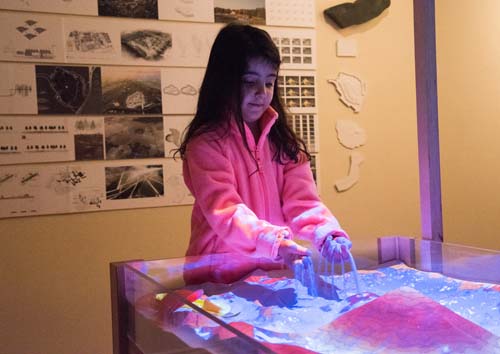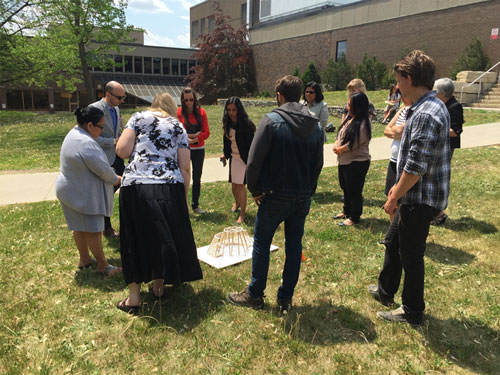Building the Cultural Landscape of Tomorrow
TEXT BY BRENDAN STEWART, OALA
Asked to think about the OALA at 50, and where our profession in Ontario is and ought to be headed, I started by contemplating the spirit of our present era.
At first, I found myself dwelling on the challenges, many of which are interrelated and seem intractable. Challenges that are boggling in scale and complexity, and that are evolving at a blinding pace: the consequences of climate change, the degradation of the natural environment, and loss of biodiversity; fake news, the seeming erosion of civil society, the rise of tribalism and populism; disruptive technologies and their unpredictable impact on our economies and ways of life; acknowledging the tragedy of Canada’s treatment of Indigenous peoples and working toward reconciliation; the forces of globalization and the growing polarization of rich and poor, urban and rural; overpopulation… The list goes on and on. The discord of our times is difficult to navigate.
Of course, there are many forces for good, too. We are living through a period of numerous progressive social movements (Me Too, Time’s Up, Black Lives Matter, Idle No More, Occupy Wall Street, to name a few), as well as dramatic technological innovation. In fact, some argue that when you zoom out and consider the plight of humanity at a global scale, we have never seen an era with so little violence and hunger and so much prosperity.1
But, ultimately, facing as we are the urgent need to learn to live more compactly and lightly, to live with less and to share more, it seems that a hopeful future depends most on our collective capacity to work together, to teach and take care of one another, and to steward our various cultures and the environment.
More than ever, landscape architects need to be conscious of the power we wield and the responsibility we are handed in shaping culture through our built work, the process of design and civic engagement, and through our education and advocacy efforts. To equip ourselves for the future, we all need to work to create a cultural landscape that enables our communities to adapt to and thrive in the more difficult times ahead, and to cultivate a sense of citizenship and stewardship.
In talking with friends and colleagues, I was reminded of the dynamic social context of the turbulent and heady late 1960s—the era during which the OALA was established. Arguably, this might be the most relevant historical period to look at for guidance in thinking about our own tumultuous times. Might recalling this period offer lessons?
The mid-1960s to mid-1970s in Canada were heavily influenced by the coming of age of the baby boomers—my parents’ generation—whose youth-led, counter-culture ideas fomented a dramatic rethinking of the social order and pushed to usher in a new hope- filled, idealistic vision of the future—a vision founded on a modern approach to what Canada is and could be.
South of the border, 1968 in particular recalls the upheaval and grimness of the Vietnam War, the assassinations of Martin Luther King, Jr. and Robert F. Kennedy, and the mass race riots of the previous summer. Tens of thousands of draft dodgers and conscientious objectors fled the U.S. for Canada during this period, bringing with them numerous luminaries—including Jane Jacobs, who arrived in Toronto with her family that same year—who went on to boldly shape Canadian culture.
On the other hand, the collective feeling in Canada in 1968 is remembered as a delirium following the previous year’s centennial celebrations, marked most notably by Expo ’67 in Montreal, an event that symbolized the “coming of age” of Canadian identity, culture, and design, and epitomized the optimism of the period.
Youth culture was wrapped up in Trudeaumania. The campus landscapes in which many young Canadians were educated had recently been re-invented by an unparalleled and idealistic period of building. In Ontario alone, the preceding decade had seen the establishment or expansion of Carleton, York, and Trent universities, Scarborough College (now U of T Scarborough), as well as the universities of Guelph and Waterloo, all in a soaring, modernist mode that exuded belief in a prosperous future.2
Landscape architects in Ontario played primary roles in many of the seminal projects of this period3 and were also at work establishing Canada’s first landscape architecture programs, at Guelph in 19644 and Toronto in 1965. Steeped in the forward-looking, hopeful, and distinctly Canadian civic values of this period, new generations of landscape architects could for the first time be trained on home turf, and, as of 1968, could gain membership in a newly established provincial association, the OALA, as they set out to leave their mark on the world through practice.
Like 2018, 1968 was a complex year in the midst of an era of profound change. As we navigate the complexities of our present era, and strategically chart the OALA’s course into the future, might we draw inspiration from the significant collective accomplishments of our forebears, charted in an era of similarly unstable times?
Consider three strategies:
1. Borrow the optimism of the past, and channel the spirit of the youth.
First, we need to be more open. Might we allow a bit of modernist optimism, hope, and sense of collective purpose to permeate our sometimes cynical, individualistic, and apathetic outlook today? Can we open our minds even more to new ideas, and invest in the passion and idealism of young practitioners as they emerge from our programs at educational institutions?

2. Nurture our roots.
Our work today is enabled by the hearty “roots” (in this analogy, the legacy) grown by OALA members in the rockier, less fertile “soils” (the cultural context) of the past—a world less aware of the value of our practice, less receptive to our ideas, and offering fewer and smaller opportunities to lead. We need to focus outwardly, and collectively nurture our roots, actively building a more productive cultural context in which to undertake our work. Beyond executing impactful projects, contributing to policy, activism, and engaging in politics, we need to focus more than ever on building broader public awareness by telling compelling stories about what we do and how we think. We need middle- school children to aspire to become landscape architects. We need to foster a culture that has higher expectations.

3. Enhance our community.
In parallel, we need to work to enhance our professional community. We need stronger linkages between research and practice, accelerating innovation in the field while strengthening our accredited programs to produce graduates who are more prepared to tackle the issues of the 21st century. We need to create a more inclusive and diverse community of OALA members that better reflects the society we serve and that welcomes more perspectives to the table, enhancing our capacity and effectiveness.

Thinking about the challenges can be exhausting, but be reminded of the fact that our capacity to address them is not static over time: landscape architects today operate on the shoulders of the practitioners of earlier generations, benefiting from the battles they fought, the ground they tilled, the seeds they sowed in the landscape and the culture. And collectively, we continue to strengthen and expand this legacy every day.
1 See Steven Pinker’s Enlightenment Now: The Case for Reason, Science, Humanism, and Progress (2018).
2 See Concrete Toronto: A Guide to Concrete Architecture from the Fifties to the Seventies, edited by Michael McClelland and Graeme Stewart (2007), for a good overview.
3 For a Toronto-centric overview, refer to The Cultural Landscape Foundation’s What’s Out There Toronto guide, supported by the OALA, available digitally at www. tclf.org/places/city-and-regional-guides/ toronto. For several articles in Ground, see “Designating modern cultural landscapes in Ontario,” by Michael McClelland, in Ground 23; “A Capital Treasure: Garden of the Provinces and Territories,” by Nicole Valois, in Ground 24; “University Avenue: Toronto’s Grand Boulevard,” by Michael McClelland and Brendan Stewart, in Ground 26; and “A modernist masterpiece: the CNIB Fragrant Garden,” by Mark Affum in Ground 27.
4 Note that the campus plan from 1965 by Project Planning Associates recently won the CSLA’s 2017 Legacy Award; see also Ron Williams’ article “University of Guelph: From Agricultural College to ‘Multiversity’” in Landscapes/Paysages, Vol 19. No.3.
BIO/ BRENDAN STEWART, OALA, CAHP, IS AN ASSISTANT PROFESSOR OF LANDSCAPE ARCHITECTURE AT THE UNIVERSITY OF GUELPH, AND AN ASSOCIATE AT ERA ARCHITECTS IN TORONTO.
